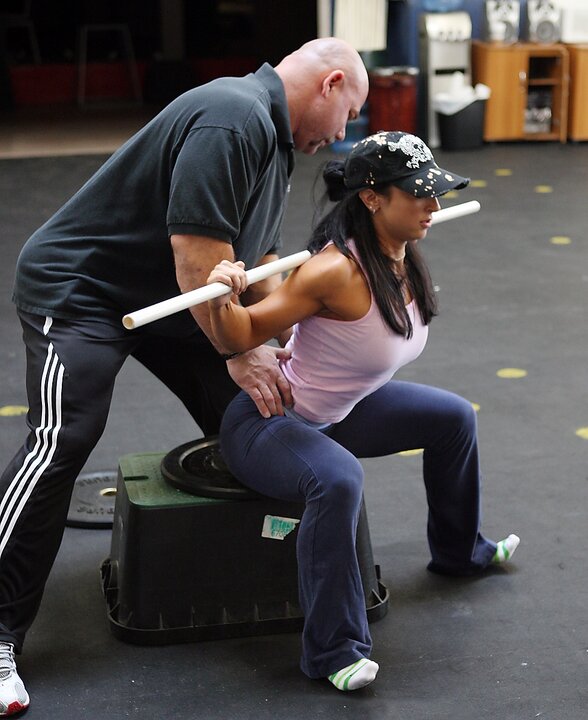Getting injured can often lead to ill health. Whether it’s an ankle, knee, back, elbow, or shoulder, being limited in what you can do and being in pain is physically and mentally exhausting. Traditionally, the road to repair focuses treatment on the injured area at the expense of the athlete’s overall training, continued development, and health. Icing, heating, ultrasound, and specific rehabilitation exercises take over to bring the injured body part back to pre-injury capacity. Unfortunately, weeks of rehab without the intensity and volume of work the athlete was doing before the injury results in a healed athlete who is less fit and healthy than before.
 CrossFit follows a different approach to rehabilitation. Instead of treating the injured area as the main focus, we address the athlete’s overall capacity as they heal. The goal is for the athlete to complete the rehab process fitter than before the injury. This is accomplished by performing constantly varied, high-intensity workouts composed of functional movements that don’t incorporate the injured area. Workouts are modified instead of scaled for as long as needed for the injured area to be incorporated back into workouts. For example, if the athlete has a broken arm, hands-free front squats, lunges, step-ups, single-leg Romanian deadlifts, thrusters, and swings with the good arm, as well as various types of single-arm pressing and pulling variations will make frequent appearances in the athlete’s workouts. So, while the athlete follows traditional rehab with a physical therapist to assist in healing the injured area, they continue to develop their overall fitness with their CrossFit workouts. The powerful neuroendocrine response stimulated by the CrossFit workouts also enhances the work done in physical therapy and promotes healing.
CrossFit follows a different approach to rehabilitation. Instead of treating the injured area as the main focus, we address the athlete’s overall capacity as they heal. The goal is for the athlete to complete the rehab process fitter than before the injury. This is accomplished by performing constantly varied, high-intensity workouts composed of functional movements that don’t incorporate the injured area. Workouts are modified instead of scaled for as long as needed for the injured area to be incorporated back into workouts. For example, if the athlete has a broken arm, hands-free front squats, lunges, step-ups, single-leg Romanian deadlifts, thrusters, and swings with the good arm, as well as various types of single-arm pressing and pulling variations will make frequent appearances in the athlete’s workouts. So, while the athlete follows traditional rehab with a physical therapist to assist in healing the injured area, they continue to develop their overall fitness with their CrossFit workouts. The powerful neuroendocrine response stimulated by the CrossFit workouts also enhances the work done in physical therapy and promotes healing.
The CrossFit athlete’s rehab process is not just about recovery but also about empowerment. It involves identifying weaknesses the athlete can address while injured and attacking these without mercy. This work will be incorporated into the athlete’s workouts and as separate practice at the beginning or end of every session. This is an excellent time for our athlete with the broken arm to develop and increase capacity in movements like pistols, hollow rocks, or GHD sit-ups. With the CrossFit rehab method, the silver lining to an injury is that the athlete gets much better at things they probably never would have worked on as hard had they not been injured. This sense of control and the ability to turn a setback into an opportunity for growth is a powerful aspect of CrossFit rehabilitation.
Once the injured area has recovered enough, it can be slowly incorporated into workouts. This process is not rushed, but rather comprehensive, ensuring that mechanics and consistency are re-established as the athlete develops a baseline of capacity. For example, now that the cast has been removed from our athlete’s arm, they can start judiciously adding planks, push-ups, bar hangs, light deadlifts, pulling and pressing movements, and light Olympic lifts. Depending on where they fit best, these can be added in warm-ups, cool-downs, or in the workouts themselves. During this time, the athlete continues to address weaknesses. Workouts continue to be modified, albeit with a broader range of available movement options, as the previously injured body part is brought up to par. This process continues until the athlete no longer has any limitations connected to the injury. At this point, the rehab process is complete, resulting in an athlete who is fitter and healthier than before getting injured. That’s a successful rehab.
CrossFit rehab provides distinct advantages to more traditional protocols. As the athlete continues to perform workouts, they’ll experience faster healing times and less atrophy. Focusing on using this time to work on weaknesses enhances overall fitness by augmenting skills and strengths that would not have been developed otherwise. Finally, the mental anguish that nearly always accompanies an athlete’s downtime is significantly reduced. Rehabbing CrossFit-style is the way to go to not only overcome an injury but to come out of it better than before. The key points to remember if you get injured are:
- Continue to do workouts consisting of a variety of functional movements performed at high intensity, modified around the injured area.
- Take advantage of this time to work on weaknesses that have been ignored.
- Once the injured area is ready, incorporate it back into workouts intelligently.
- Remember that CrossFit is health, and sitting out for any length of time will impact overall health.
These simple principles are the key to implementing an effective rehab protocol. Those who have been injured but have the good fortune of rehabbing with CrossFit know that CrossFit is about more than being able to do certain movements with certain body parts. It’s about overall health that can continue to be achieved through infinite scalability, no matter the injury.
Resources
- Working Wounded by Greg Glassman
- Injured? Don’t Skip the Gym by Kelley Laxton
About the Author
 Stephane Rochet is a Senior Content Writer for CrossFit. He has worked as a Flowmaster on the CrossFit Seminar Staff and has over 15 years of experience as a collegiate/tactical strength and conditioning coach. He is a Certified CrossFit Trainer (CF-L3) and enjoys training athletes in his garage gym.
Stephane Rochet is a Senior Content Writer for CrossFit. He has worked as a Flowmaster on the CrossFit Seminar Staff and has over 15 years of experience as a collegiate/tactical strength and conditioning coach. He is a Certified CrossFit Trainer (CF-L3) and enjoys training athletes in his garage gym.
Comments on CrossFit is Health: Using CrossFit to Rehab an Injury
OMG that picture. Dave Tate teaching box squats!
update: CrossFit Journal, 2009. I found the video! https://youtu.be/Obs0rqXodlg?si=BSyp9zSZ_rW0qa54
CrossFit is Health: Using CrossFit to Rehab an Injury
2